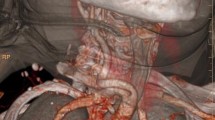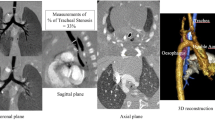Abstract
Purpose
To measure the age-dependent changes of anatomical positions and relations between the trachea, cricoid cartilage (CC), and innominate artery (IA) in adults by computed tomography (CT).
Methods
A retrospective cohort reviewing images of 127 consecutive adult patients who underwent CT angiography (CTA) of the neck. The trachea-to-IA (T–IA) distance was measured as the minimal horizontal distance between them. The vertical distance between the CC and the IA was measured between the axial section, demonstrating the CC’s inferior border to the axial section at the level of the T-IA measurement.
Results
Images of 125 patients (median age 53 years, range 18–89; 74 males) were reviewed. The mean T–IA distance was 2.3 ± 1.1 mm for males and 1.7 ± 0.9 mm for females (P = 0.002). The vertical C–IA distance was 44.2 ± 11.4 mm and 49.5 ± 12.5 mm for males and females, respectively (P = 0.01). Age correlated negatively with the vertical C–IA distance (P < 0.0001) and positively with the T–IA distance (P < 0.0001). The rate of IA variants was 23.2%, with no significant difference between the measurements of distances among patients with or without IA variants.
Conclusions
This is the first description of the relationships between the trachea, CC, and IA distances in adults as depicted on CTA. The T–IA distance becomes larger while the T–CC distance becomes shorter with age.



Similar content being viewed by others
References
Goldenberg D, Golz A, Netzer A, Joachims HZ (2002) Tracheotomy: changing indications and a review of 1,130 cases. J Otolaryngol 31:211–215
Sagiv D, Nachalon Y, Glikson E et al (2018) Awake tracheostomy—indications, complications and outcome. World J Surg 42:2792–2799
Maruti Pol M, Gupta A, Kumar S, Mishra B (2014) Innominate artery injury: a catastrophic complication of tracheostomy, operative procedure revisited. BMJ Case Rep. https://doi.org/10.1136/bcr-2013-201628
Okada Y, Narumiya H, Ishii W, Ryoji I (2016) Damage control management of innominate artery injury with tracheostomy. Surg Case Rep 2:17. https://doi.org/10.1186/s40792-016-0144-7
Gelman JJ, Aro M, Weiss SM (1994) Tracheo-innominate artery fistula. J Am Coll Surg 179:626–634
Jones JW, Reynolds M, Hewitt RL, Drapanas T (1976) Tracheo-innominate artery erosion: successful surgical management of a devastating complication. Ann Surg 184:194–204
Wood DE, Mathisen DJ (1991) Late complications of tracheostomy. Clin Chest Med 12:597–609
Oshinsky AE, Rubin JS, Gwozdz CS (1988) The anatomical basis for post-tracheostomy innominate artery rupture. Laryngoscope 98:1061–1064
Fawcett SL, Gomez AC, Hughes JA, Set P (2010) Anatomical variation in the position of the brachiocephalic trunk (innominate artery) with respect to the trachea: a computed tomography-based study and literature review of innominate artery compression syndrome. Clin Anat 23:61–69
Dumfarth J, Chou AS, Ziganshin BA et al (2015) Atypical aortic arch branching variants: a novel marker for thoracic aortic disease. J Thorac Cardiovasc Surg 149:1586–1592
Sagiv D, Eyal A, Mansour J, Nakache G, Wolf M, Primov-Fever A (2016) Novel anatomic characteristic of the laryngeal framework: a computed tomography evaluation. Otolaryngol Head Neck Surg 154:674–678
Glikson E, Sagiv D, Eyal A, Wolf M, Primov-Fever A (2017) The anatomical evolution of the thyroid cartilage from childhood to adulthood: a computed tomography evaluation. Laryngoscope J 127:E354–E358
Johnson KN, Botros DB, Groban L, Bryan YF (2015) Anatomic and physiopathologic changes affecting the airway of the elderly patient: implications for geriatric-focused airway management. Clin Interv Aging 10:1925–1934
Fehlings MG, Tetreault L, Nater A et al (2015) The aging of the global population: the changing epidemiology of disease and spinal disorders. Neurosurgery 77(Suppl 4):S1–S5
Yamashiro Y, Kryger M (2012) Is laryngeal descent associated with increased risk for obstructive sleep apnea? Chest 141:1407–1413
Sung JH, Kim IS, Yang SH, Hong JT, Son BC, Lee SW (2011) Is computerized tomography angiographic surveillance valuable for prevention of tracheoinnominate artery fistula, a life-threatening complication after tracheostomy? J Korean Neurosurg Soc 49:107–111
Funding
None.
Author information
Authors and Affiliations
Corresponding author
Ethics declarations
Conflict of interest
There are no financial or personal conflicts of interest to declare.
Ethical approval
The study was approved by the Sheba Medical Center Institutional Review Board. All procedures performed in studies involving human participants were in accordance with the ethical standards of the institutional and/or national research committee and with the 1964 Helsinki declaration and its later amendments or comparable ethical standards.
Informed consent
Retrospective study without intervention, data was retrieved anonymously from medical charts with no identifying information. Informed consent was not required by the Medical Center Institutional Review Board.
Additional information
Publisher's Note
Springer Nature remains neutral with regard to jurisdictional claims in published maps and institutional affiliations.
Rights and permissions
About this article
Cite this article
Sagiv, D., Hadad, L., Eyal, A. et al. Imaging of the age-related anatomical relationship between the innominate artery and the trachea. Eur Arch Otorhinolaryngol 276, 2001–2005 (2019). https://doi.org/10.1007/s00405-019-05474-w
Received:
Accepted:
Published:
Issue Date:
DOI: https://doi.org/10.1007/s00405-019-05474-w




